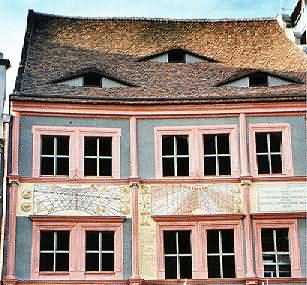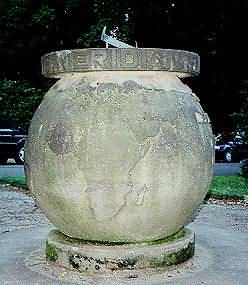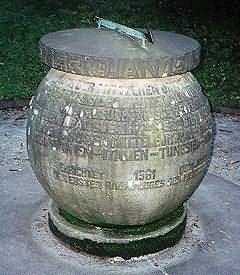 For
a full overview click
here
For
a full overview click
here  For
a full overview click
here For
a full overview click
here GÖrlitz sundial trail |
|---|
by Martha A. Villegas y José C. Montes J.Highlights : Astronomic clock, two sundials Solarium and Arachne, Meridian 15° E monument and horizontal sundial. You can see a digital map of Görlitz at: http://www.eurotour.goerlitz.de/eurotour/inhalt.html Görlitz is a small an lovely city in Germany whose origins go back to 1017. It is located approximately 200 km south of Berlin, it lies at the border with Poland and very close to Prague. The visit to Görlitz is greatly justified getting to know its famous double sundial manufactured by Zacharias Scultetus in 1550, in which art and the various information a sundial may comprise is plainly displayed It is recommended to make the tour by foot to enjoy the enormous city attractions as the buildings decorated with weathervanes of multiple figures, classical towers, fountains and the nice view of the Niesse River dividing Poland and Germany. Beginning the trail  You may start the tour in Demianiplatz, the square where the tourist buses
arrive. The main buildings in this square are: Kaisertrutz, a big building
with two towers, Reichenberger Tower and He Natural Science Museum (Naturkunde
Museum). Walking northeast from Demianiplatz you will get to the Central
Plaza (Obermarkt).
You may start the tour in Demianiplatz, the square where the tourist buses
arrive. The main buildings in this square are: Kaisertrutz, a big building
with two towers, Reichenberger Tower and He Natural Science Museum (Naturkunde
Museum). Walking northeast from Demianiplatz you will get to the Central
Plaza (Obermarkt).The distance from the main station to the city entre is about 2 m. To get to Obermarkt, walk down Berlinstraße and in your way you will pass the Post Square (Postplatz), a Church (Frauenkirche), a fountain and a huge white tower (Dicke turm). When you get to this tower you walk two blocks down Steinstrasse, and you are in the Central Plaza (Obermarkt). ROSA DE LOS VIENTOS: EArriving in Obermarkt you walk (northeast) and at the end of the Plaza you find anoctagonal fountain where the cardinal points are signaled by an enormous wind rose displayed on the combined color cobblestone pavement as well as bronze inlaid letters . ASTRONOMICAL CLOCK:: Continuing walking northeast on Brüderstrasse, you pass a second plaza (Untermarkt), the Justice Hall (Rathausstreppe mit Justitiasäule) until you get to Neptune Fountain or wish fountain (Neptunbrunnen). From there you can view the City Hall (Rathaus) which stands out for its four mechanical clocks in the tower and its overwhelming two faces Astronomical Clock in its northeast wall, manufactured in 1584, by Bartholomäus Scultetus, a famous artist born in Görlitz. In the upper part of the clock there is a window with a golden lion lying in it which is said to had whistle in some phases of the moon. The upper face has a 24 hour division circle and another circle with the phases of the moon (moondial). One of its two hands indicates the moon cycle and the other one indicates the time.
DOUBLE SUNDIAL::  The lower face is a clock that indicates the legal time. The lower face is a clock that indicates the legal time.
Walking northward (going down), towards the second part of the plaza Untermarkt, around 200 km far, there is a pharmacy (Ratsapotheke), which displays on its facade two sundial manufactured by the Mathematician Zacharias Scultetus in 1550. The Major of the City wanted a clock to show the cycle of the planets and the zodiac constellations. They also wanted it to be possible to read the different kind of hours, such as temporaries, Babilonics and Italians. Due to the great amount of information required, it was necessary to build two sundials, the first one Solarium (Sonnenweiser) meaning order of the Sun and the second one Arachne (Spinnennetz) meaning spider web. This sundial is commonly used within the city as the solar and the legal time coincide here and no adjustments need to be made due to the position of Görlitz on meridian 15° E .  If you want to get to know the details on this clock, you may see: : http://tirol-php.highway.telekom.at/k.schwarzinger/d_6243.htm In this page Mr. Karl Schwarzinger fully describes the backgrounds of this sundial, the gnomonic contains, measures, restoration dates, etc.  MONUMENTO AL MERIDIANO 15° E : From the pharmacy, you walk down Peterstrasse, which takes you to "Peterkirche" (St. Peter Chruch) located at the banks of River Neisse from where you may overlook Poland. To get to the park (Stadtpark) where the Meridian 15° monument stands, you walk about 1 km southeast following the river bank by Uferstrasse; pass the Hotel Mercure and close to Stadthalle Görlitz, in an area fully covered by plants, you will find the monument representing Meridian 15° E, which corresponds to Central Europe Meridian. It was built to commemorate the first launch into the space of soviet cosmonaut Yuri Gagarin, in 1961.   It is a small an spherical monument with a bronze track in the horizontal plan which indicates exactly the direction and position of the meridian. In the middle of the sphere facing north it has a map with a vertical line which indicates the countries crossed by this meridian; in the other half facing south it has an inscription with the names of such countries and an explanation on the monument.
|